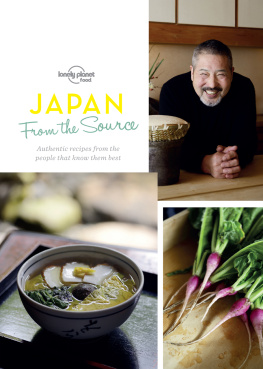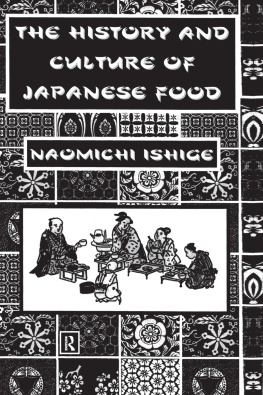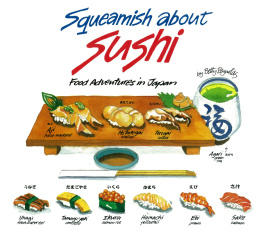Recent Titles in The Global Kitchen
Food Cultures of the United States: Recipes, Customs, and Issues
Bruce Kraig
Food Cultures of Israel: Recipes, Customs, and Issues
Michael Ashkenazi
Food Cultures of France: Recipes, Customs, and Issues
Maryann Tebben
Food Cultures of Mexico: Recipes, Customs, and Issues
R. Hernandez-Rodriguez
FOOD CULTURES OF JAPAN
Recipes, Customs, and Issues
Jeanne Jacob
The Global Kitchen

Copyright 2022 by ABC-CLIO, LLC
All rights reserved. No part of this publication may be reproduced, stored in a retrieval system, or transmitted, in any form or by any means, electronic, mechanical, photocopying, recording, or otherwise, except for the inclusion of brief quotations in a review, without prior permission in writing from the publisher.
The publisher has done its best to make sure the instructions and/or recipes in this book are correct. However, users should apply judgment and experience when preparing recipes, especially parents and teachers working with young people. The publisher accepts no responsibility for the outcome of any recipe included in this volume and assumes no liability for, and is released by readers from, any injury or damage resulting from the strict adherence to, or deviation from, the directions and/or recipes herein. The publisher is not responsible for any readers specific health or allergy needs that may require medical supervision, nor for any adverse reactions to the recipes contained in this book. All yields are approximations.
Library of Congress Cataloging-in-Publication Data
Names: Jacob, Jeanne, author.
Title: Food cultures of Japan : recipes, customs, and issues / Jeanne Jacob.
Description: Santa Barbara, California : Greenwood, an imprint of ABC-CLIO, LLC, [2022] | Series: The global kitchen | Includes bibliographical references and index.
Identifiers: LCCN 2021012448 (print) | LCCN 2021012449 (ebook) | ISBN 9781440866838 (hardcover) | ISBN 9781440866845 (ebook)
Subjects: LCSH: Food habitsJapan. | Cooking, Japanese. | JapanSocial life and customs.
Classification: LCC GT2853.J3 J33 2021 (print) | LCC GT2853.J3 (ebook) | DDC 394.0952dc23
LC record available at https://lccn.loc.gov/2021012448
LC ebook record available at https://lccn.loc.gov/2021012449
ISBN: 978-1-4408-6683-8 (print)
978-1-4408-6684-5 (ebook)
26 25 24 23 22 1 2 3 4 5
This book is also available as an eBook.
Greenwood
An Imprint of ABC-CLIO, LLC
ABC-CLIO, LLC
147 Castilian Drive
Santa Barbara, California 93117
www.abc-clio.com
This book is printed on acid-free paper 
Manufactured in the United States of America.
Contents
Series Foreword
Imagine a typical American breakfast: bacon, eggs, toast, and home fries from the local diner. Or maybe a protein-packed smoothie, sipped on the go to class or work. In some countries in Europe, breakfast might just be a small cookie and a strong coffee, if anything at all. A South African breakfast might consist of a bowl of corn porridge with milk. In Japan, breakfast might look more like dinner, complete with rice, vegetables, and fish. What we eat varies from country to country, and even region to region. The Global Kitchen series explores the cuisines of different cultures around the world, from the history of food and food staples to main dishes and contemporary issues. Teeming with recipes to try at home, these volumes will delight readers by discovering other cultures through the lens of a treasured topic: food.
Each volume focuses on the culinary heritage of one country or one small group of countries, covering history and contemporary culture. Volumes begin with a chronology of major food-related milestones and events in the area, from prehistory to present. Chapters explore the key foods and meals in the country, covering the following topics:
- Food History;
- Influential Ingredients;
- Appetizers and Side Dishes;
- Main Dishes;
- Desserts;
- Beverages;
- Holidays and Special Occasions;
- Street Foods and Snacks;
- Dining Out; and
- Food Issues and Dietary Concerns.
Chapters are textual, and each chapter is accompanied by numerous recipes, adding a hands-on component to the series. Sidebars, a glossary of important terms, and a selected bibliography round out each volume, providing readers with additional information and resources for their personal and scholarly research needs.
Whether readers are looking for recipes to use for classes or at home, or to explore the histories and traditions of world cuisines, the Global Kitchen series will allow readers to fully immerse themselves in other cultures, giving a taste of typical daily life and tradition.
Preface
What is food like in Japan today? It is certainly not all raw fish, despite sushi and sashimi topping the list of Japanese diners favorites. Nor is it always tempura or steaks on a teppan , the offerings of pioneering Japanese restaurants outside Japan. Meals vary widely andperhaps unsurprisingly in our global agehappily mix local and international dishes, especially in major urban areas. A weekday family breakfast of toast with butter and jam, and eggs with sausages, is not unusual. Lunch for an office worker in a major city such as Tokyo or Osaka could be Vietnamese pho, or Chinese-style fried rice, or Central Asian-flavored noodles. Supper for a young family is likely to be the childrens choice of hamburger, eaten with rice, at a family restaurant. In contrast, young working adults prefer to drink and eat at an izakaya , where specialty seafoods, such as grilled giant shrimp and crab coral ( kani miso ), are paired with regional craft sake , as crisp and dry as white wine. A cold day may be perfect for a nostalgic sweet red bean soup with tiny dumplings, and for the evening, a hot-pot ( nabe ) of meat and vegetables, cooked on a tabletop stove. Foods familiar to Americans and some not so familiar, such as Baumkuchen and choux la crme ( sh kur mu ), are widely available. Neighborhood convenience stores ( kombini ) have these and cooked foods tooa hodge-podge stew called oden simmering away, grilled skewered chicken ( yakitori ), and meat-filled buns ( nikuman ) piping hot. Mukokuseki (without a nationality) is how many Japanese describe this eclectic, gastronomic landscape common to urban areas.
Since the 1960s, once Japans economy had recovered from the war, the ideal meal of white rice, miso soup, and pickled vegetables plus two or more side dishes of fresh ( not salted or preserved) fish and seafood or meat and cooked vegetables had become attainable for the majority. Less than half a century later, however, many are too busy to prepare such a meal other than on weekends. Fifty years ago, every component of a traditional meal would have been prepared from scratch. Each household had its unique way of fermenting miso and vegetable pickles, imbuing them with what is fondly known as ofukuro no aji (the taste of moms cooking).
Todays lifestyles make the daily re-creation of such meals unfeasible for working people. The variety of cooked dishes readily bought at reasonable prices from supermarkets, department store food sections, and convenience stores makes it too easy not to cook from scratch. Japanese meals today tend to focus less on rice and fish, and more on chicken, pork, beef, and dairy products. With the sheer diversity of ingredients imported from all over the world, nontraditional vegetables, herbs, and other condiments (and ways of cooking and eating them) have become commonplace, not only in specialist kitchens and gourmet restaurants, but in the average home kitchen, too.
Next page









